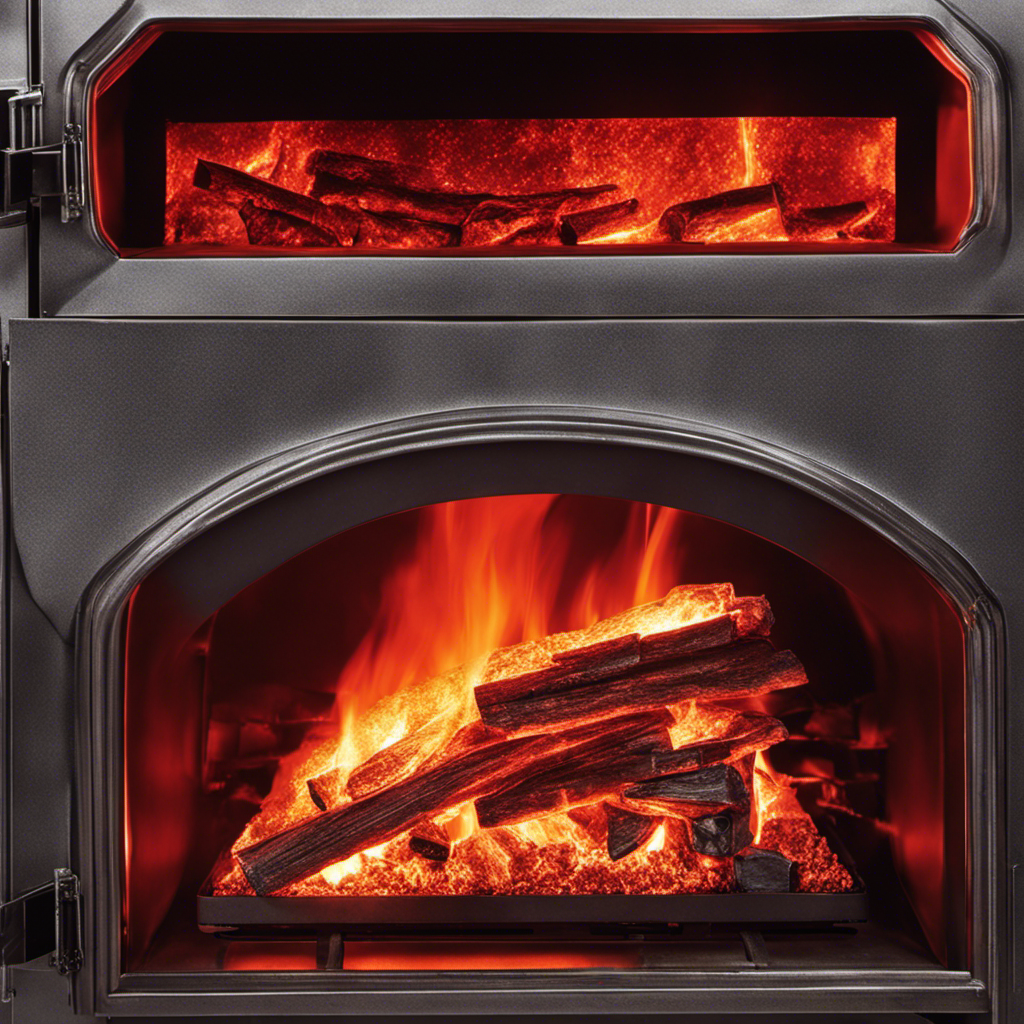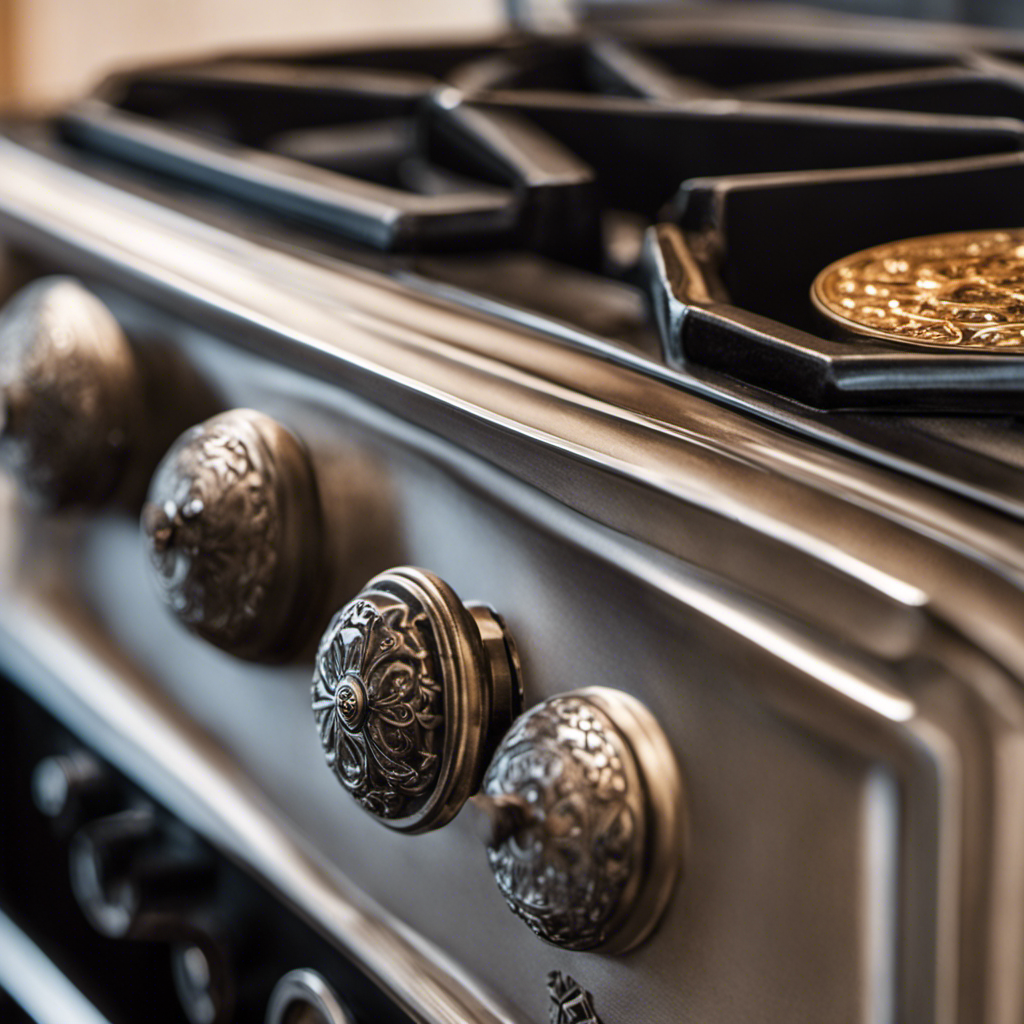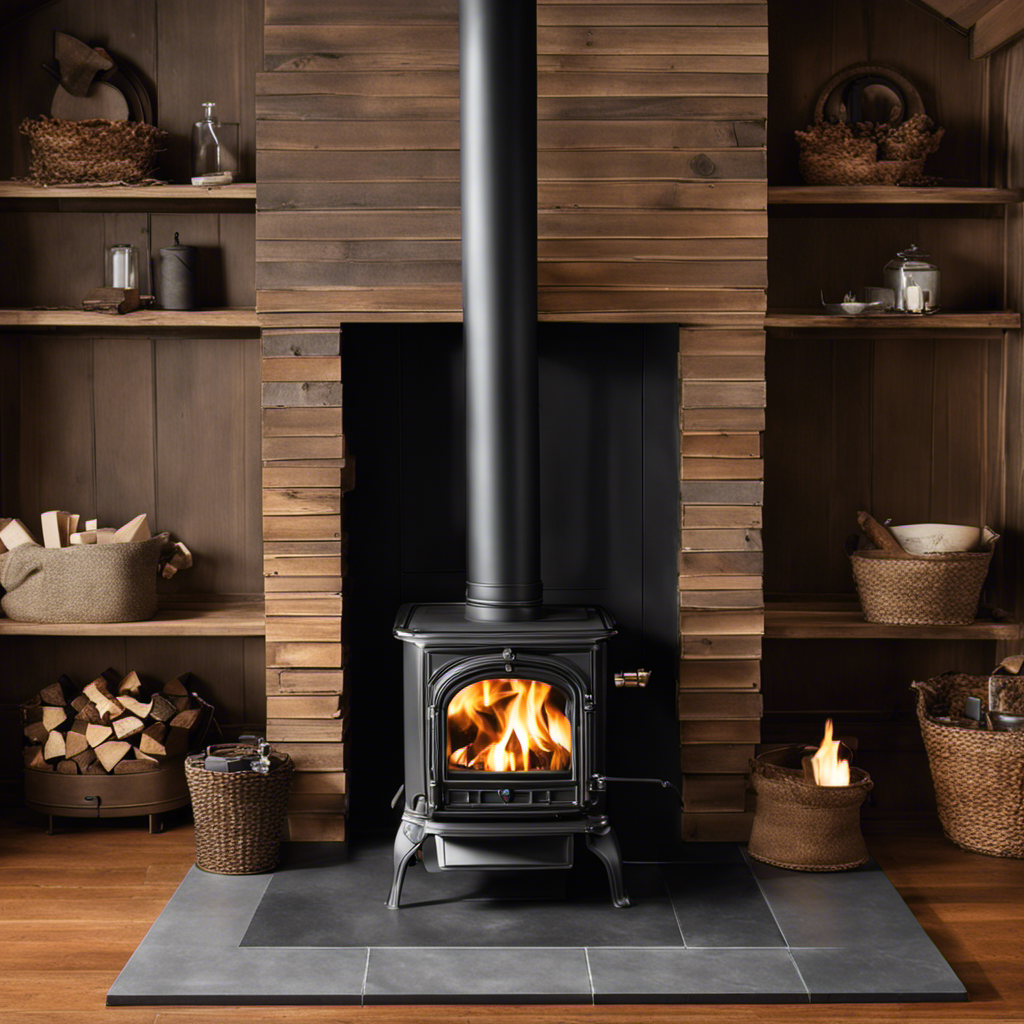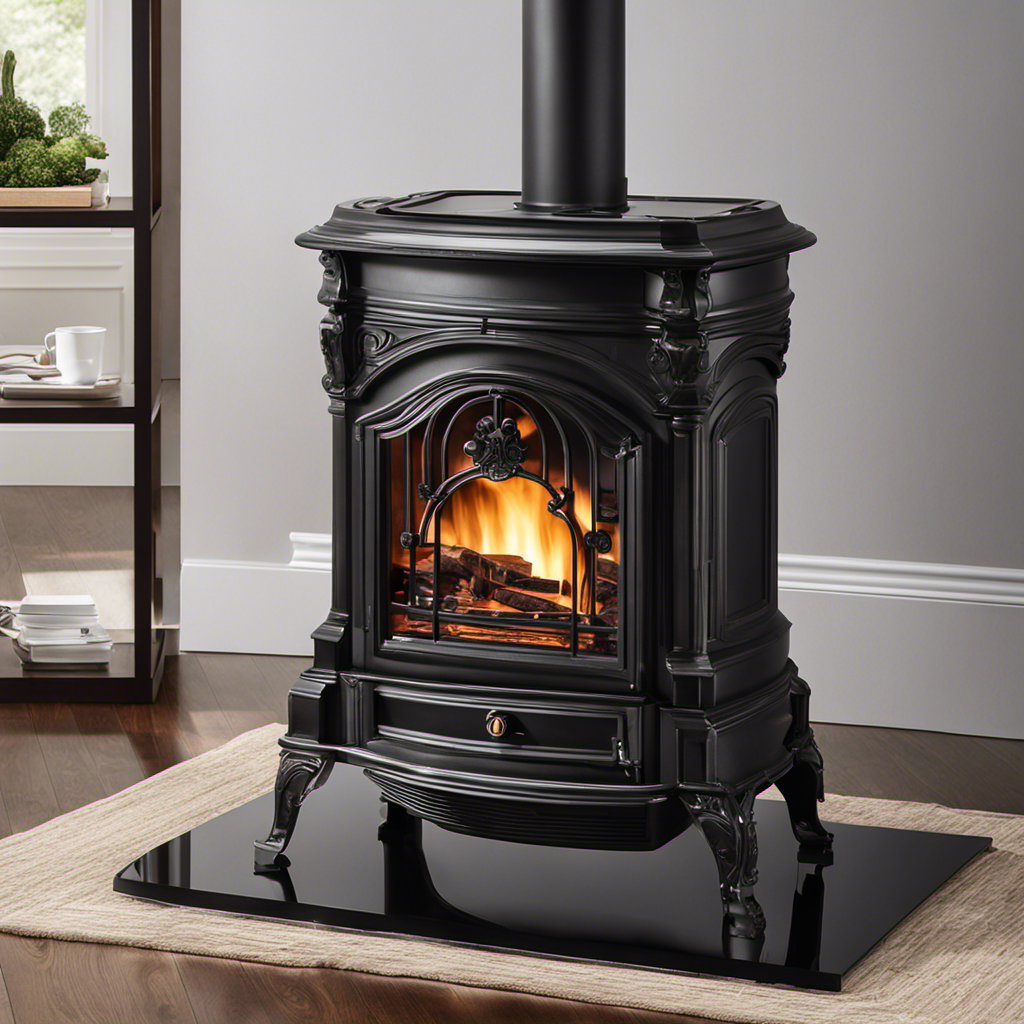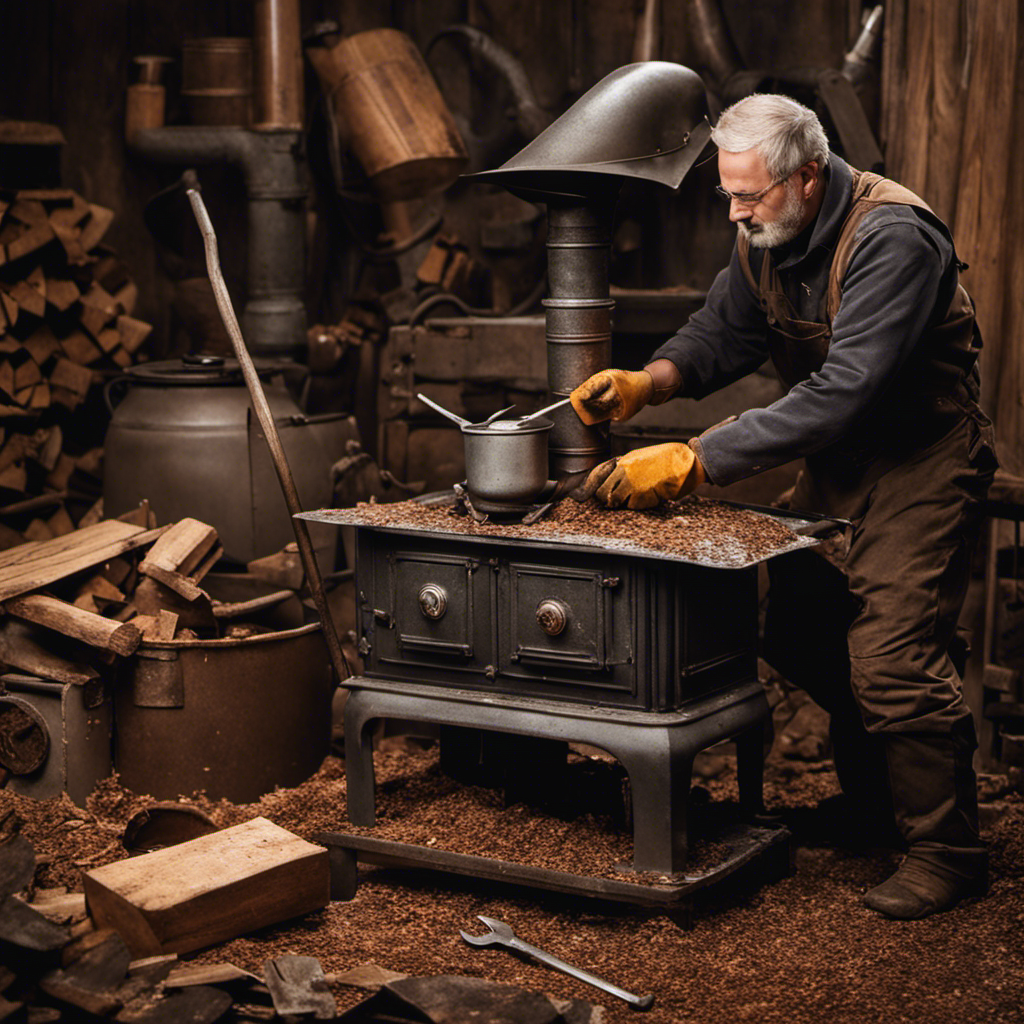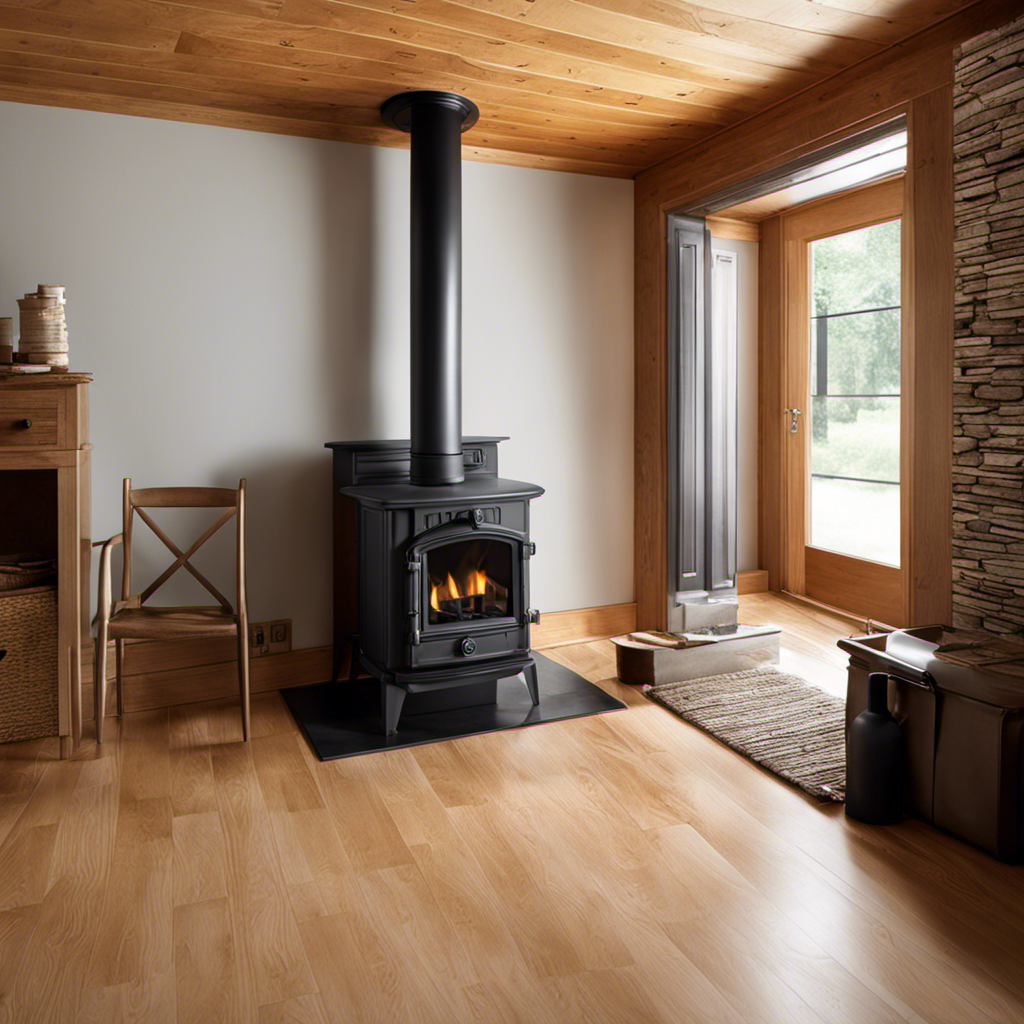Installation & Maintenance
Efficient and Convenient: The Truth About Pellet Stove Maintenance

Welcome to our guide on maintaining your pellet stove in excellent condition! As homeowners who have personally reaped the benefits, we recognize the significance of regular upkeep and cleaning to ensure peak performance.
Pellet stoves offer convenience and cozy warmth, but they do require more maintenance. Fear not! With the right knowledge and regular care, pellet stoves can provide trouble-free use for years.
In this article, we’ll cover cleaning routines, maintenance tasks, and share helpful tips to make your pellet stove maintenance easier. Let’s dive in and keep your pellet stove in top shape!
Key Takeaways
- Pellet stoves require daily and weekly cleaning to ensure optimal performance and safety.
- Regular seasonal maintenance, including cleaning and inspecting various components, is necessary to prevent buildup and ensure efficient operation.
- Yearly maintenance, such as inspecting the flue system and having the stove serviced by a qualified technician, is important for safe and efficient operation.
- Following manufacturer’s guidelines and using high-quality cleaners designed for pellet stoves can simplify maintenance and prolong the lifespan of the stove.
Pellet Stove Cleaning Basics
Regular daily cleaning helps prevent fire hazards and ensures our pellet stove functions properly.
To maintain our pellet stove, it’s important to follow these maintenance tips.
- Dispose of ashes in a metal container away from flammable materials.
- Use a small brush or vacuum to remove debris from the combustion area.
- Refer to the instruction manual for specific instructions on removing and replacing the combustion area.
In addition to daily cleaning, perform a weekly deep clean.
- Clean the ignition to remove dust and debris that can affect its performance.
- Empty the hopper before cleaning to avoid dust and debris in the pellets.
- If the stove has been unused for an extended period, use a vacuum to clean the surface.
Daily Cleaning for Optimal Performance
To keep our pellet stove performing at its best, we make sure to clean it daily. Daily cleaning offers numerous benefits, such as improved performance and increased safety. Here are three key benefits of daily cleaning:
-
Optimal Performance: Regularly cleaning your pellet stove ensures that it operates efficiently. Removing debris from the combustion area and cleaning the ignition system helps maintain proper pellet ignition and a consistent burn. This results in a more efficient and effective heat output.
-
Safety: Daily cleaning helps prevent fire hazards. By removing ashes and debris from the burn pot and combustion area, you reduce the risk of ignition and potential damage to your stove and home. It also allows for better airflow, reducing the chances of carbon monoxide buildup.
-
Troubleshooting Common Cleaning Issues: Daily cleaning gives you the opportunity to identify and address any potential issues before they become major problems. By inspecting the stove regularly, you can troubleshoot common cleaning issues such as clogged vents, dirty sensors, or worn-out gaskets.
Proper Disposal of Ashes
When it comes to disposing of ashes from our pellet stove, we always make sure to follow proper safety guidelines. Proper ash disposal is crucial to prevent creosote buildup and maintain the efficiency and safety of the stove. To create imagery in your mind, here is a table that illustrates the steps we take for proper ash disposal:
| Steps for Proper Ash Disposal |
|---|
| 1. Allow the ashes to cool completely. |
| 2. Use a metal shovel or scoop to transfer the ashes into a metal container. |
| 3. Ensure the metal container is tightly sealed to prevent any embers from escaping. |
| 4. Place the metal container outside, away from any flammable materials. |
| 5. Never dispose of ashes in plastic bags or cardboard boxes. |
Removing Debris From the Combustion Area
As we clean our pellet stove, we always make sure to remove any debris from the combustion area to ensure optimal performance. Here’s how we do it:
-
Use the appropriate cleaning tools: We recommend using a small brush or vacuum to remove debris from the combustion area. This helps to prevent any blockages or obstructions that can affect the stove’s efficiency.
-
Troubleshoot common issues: If you notice any issues with the combustion area, such as poor ignition or uneven burning, it may be necessary to clean it more thoroughly. Check the manufacturer’s instructions for guidance on removing and replacing the combustion area.
-
Regular maintenance is key: By regularly cleaning the combustion area, you can prevent fire hazards and ensure that your pellet stove functions properly. Make sure to perform this cleaning task as part of your daily and weekly maintenance routine.
Weekly Deep Cleaning Tips
During our weekly deep cleaning routine, we focus on thoroughly cleaning all parts of the pellet stove to ensure optimal performance. Regular deep cleaning is essential to maintain the efficiency and safety of the stove.
We recommend performing a deep clean at least once a week to remove any built-up ash, soot, or debris. This frequency may vary depending on usage and environmental factors.
When disposing of the ash and debris, it’s crucial to follow proper disposal methods to prevent fire hazards. We advise using a metal container for ash disposal and keeping it away from flammable materials. Additionally, always check the manufacturer’s guidelines for specific instructions on how to clean and dispose of waste properly.
Maintaining the Ignition System
To keep our pellet stove’s ignition system functioning properly, we regularly clean it to remove any dust or debris that could affect its performance. Ignition system maintenance is crucial for ensuring reliable and efficient operation of your pellet stove.
Here are some key steps to maintain and troubleshoot the ignition system:
-
Clean the Ignition: Regularly clean the ignition to remove dust and debris that can hinder proper pellet ignition. Use a soft brush or compressed air to gently remove any buildup.
-
Check the Wiring: Inspect the electrical cables connected to the ignition system for any signs of wear or damage. Replace any damaged cables to prevent potential malfunctions.
-
Troubleshoot Ignition Issues: If you encounter ignition problems, check the fuel supply, ensure the igniter is properly positioned, and check for any blockages in the fuel delivery system. Consult the manufacturer’s manual or contact a professional technician for further assistance.
Emptying the Hopper Before Cleaning
When it comes to hopper maintenance in pellet stoves, one important step is emptying the hopper before cleaning. This ensures that any dust or debris that may have accumulated in the hopper doesn’t contaminate the new pellets.
To empty the hopper, first, turn off the stove and unplug it from the power source. Then, carefully remove any remaining pellets from the hopper, making sure to place them in a secure container for later use.
Once the hopper is empty, you can proceed with cleaning the rest of the stove, including the combustion area, ignition system, and sensors.
Vacuuming the Stove’s Surface
Regularly vacuuming the surface of our stove helps keep it clean and free from dust and debris. Here are some vacuuming techniques to prevent dust buildup:
-
Use a vacuum cleaner with a brush attachment: This attachment is designed to gently sweep away dust and debris without scratching the stove’s surface.
-
Start from the top and work your way down: Begin vacuuming from the highest point of the stove and gradually move downward. This ensures that any dislodged dust falls onto areas that haven’t yet been cleaned.
-
Pay attention to crevices and corners: Dust tends to accumulate in hard-to-reach areas. Use the crevice tool or a small brush to remove dust from corners, edges, and other tight spaces.
Seasonal Maintenance for Soot and Ash Buildup
Now that we’ve covered the importance of vacuuming the stove’s surface, let’s move on to discussing seasonal maintenance for soot and ash buildup. This is a crucial aspect of pellet stove maintenance because it helps prevent the accumulation of creosote, a highly flammable substance that can lead to chimney fires.
To effectively prevent soot and ash buildup, it’s essential to clean the inside and outside of the pellet stove regularly. This includes removing any residue from the burn pot, heat exchanger, and exhaust system. Additionally, it’s important to check the door seal and replace it if necessary to ensure proper heat retention.
While regular cleaning is vital, it’s equally important to emphasize the significance of professional servicing. A qualified technician should inspect and clean the entire system annually. This not only ensures safe and efficient operation but also allows for early detection of any potential issues that may arise.
Checking and Replacing Door Seals
To ensure proper heat retention and prevent heat loss, we should regularly check and replace the door seals on our pellet stove. The door seals play a crucial role in maintaining the efficiency and effectiveness of the stove by creating a tight seal between the door and the stove body. Over time, these seals can become worn or damaged, leading to issues such as air leaks and decreased heat retention.
Here are three important steps to follow when replacing worn seals and troubleshooting door seal issues:
-
Visual Inspection: Carefully examine the door seals for any signs of wear, tears, or gaps. Look for areas where the seal may have become loose or detached from the door or stove body.
-
Cleaning and Lubrication: Before replacing the seals, clean the surfaces where the seals will be attached. Use a mild detergent and water to remove any dirt or debris. Apply a small amount of high-temperature lubricant to ensure smooth movement and proper sealing.
-
Replacement: If the door seals are worn or damaged beyond repair, it’s necessary to replace them. Refer to the manufacturer’s instructions for the specific type and size of seals required for your pellet stove. Carefully remove the old seals and install the new ones, making sure they’re aligned properly and securely attached.
Inspecting and Repairing Electrical Cables
Inspecting and repairing electrical cables is an important step in ensuring the safe and reliable operation of our pellet stove. Electrical connections play a crucial role in the functioning of the stove, and any issues with the cables can lead to malfunctions or even pose a safety hazard.
To properly inspect the electrical cables, follow these steps:
-
Start by visually inspecting the cables for any signs of wear, damage, or loose connections. Look for frayed wires, exposed conductors, or burnt marks.
-
Use a multimeter to test the continuity of the cables. This will help identify any breaks or faults in the wiring.
-
Troubleshoot any cable issues by systematically checking each component connected to the cables. Check the control board, motors, and sensors for any loose connections or faulty wiring.
Cleaning the Ignition System Regularly
Regularly cleaning the ignition system ensures that it functions properly and ignites the pellets efficiently. Ignition system troubleshooting can help identify and resolve common ignition system issues. Here are some important points to consider:
-
Clean the ignition system regularly: Dust and debris can accumulate on the ignition components, affecting their performance. Regular cleaning helps ensure a reliable ignition every time.
-
Check for damaged or worn parts: Over time, ignition system components can become damaged or worn out. Inspect the ignition electrode, flame sensor, and wiring for any signs of wear or damage. Replace any faulty parts to maintain optimal performance.
-
Test the ignition system: If you’re experiencing ignition problems, it’s important to troubleshoot the system. Check the spark output, electrode alignment, and fuel delivery to identify any issues and address them promptly.
Preventing Malfunctions With Sensor Cleaning
By regularly cleaning the sensors, we can prevent malfunctions and ensure the proper functioning of our pellet stove.
The sensors in a pellet stove play a crucial role in monitoring and controlling various aspects of the stove’s operation. Over time, these sensors can become dirty or covered in soot and ash, which can affect their accuracy and performance.
To maintain optimal sensor performance, it’s important to include sensor maintenance as part of our regular cleaning routine.
Start by turning off the stove and allowing it to cool down. Use a soft brush or compressed air to gently remove any debris or buildup from the sensors. Be careful not to damage or dislodge the sensors during cleaning.
Yearly Flue Inspection and Cleaning
To ensure our safety and prevent fire hazards, it’s essential for us to have the flue system of our pellet stove inspected and cleaned yearly.
The flue is an integral part of the pellet stove that helps exhaust the byproducts of combustion safely out of our homes.
Neglecting flue maintenance can lead to the buildup of creosote, a highly flammable substance that can cause chimney fires.
Regular inspection and cleaning of the flue system not only prevent fire hazards but also ensure the efficient operation of our pellet stoves.
A professional technician can identify and repair any cracks or deterioration in the flue system, ensuring that it functions properly.
Frequently Asked Questions
How Often Should I Clean My Pellet Stove’s Combustion Area?
We should clean the pellet stove’s combustion area daily to ensure optimal performance and safety. Regular cleaning prevents fire hazards and maintains proper functioning.
In addition to daily cleaning, a weekly deep clean is recommended. When cleaning, we should use a small brush or vacuum to remove debris and dispose of ashes in a metal container away from flammable materials.
Following these maintenance tips will help keep our pellet stove running smoothly.
What Should I Do With the Ashes From My Pellet Stove?
When it comes to the ashes from your pellet stove, there are a few things you can do.
Proper disposal is important to ensure safety and prevent any fire hazards.
One option is to use the ashes as a natural fertilizer in your garden.
They can also be used to melt ice on your driveway or walkways during the winter months.
Just make sure to let the ashes cool completely before handling and always dispose of them in a metal container away from any flammable materials.
How Often Should I Deep Clean My Pellet Stove?
We should deep clean our pellet stove at least once a week to maintain its efficiency and safety. This involves cleaning the ignition system, emptying the hopper before cleaning, and using a vacuum to clean the stove’s surface.
As for proper ash disposal, we should dispose of ashes in a metal container away from flammable materials.
Regular deep cleaning and proper ash disposal are essential for the optimal performance and longevity of our pellet stove.
Can I Vacuum the Surface of My Pellet Stove?
Yes, you can definitely vacuum the surface of your pellet stove.
It’s a simple and effective way to maintain the cleanliness and appearance of your stove.
Just make sure to use a vacuum cleaner with a brush attachment to gently remove any dust or debris from the surface.
Regular vacuuming will help prevent the buildup of dirt and keep your pellet stove looking great.
How Often Should I Inspect and Clean the Flue System of My Pellet Stove?
We should inspect and clean the flue system of our pellet stove at least once a year. During the inspection, we should check for any cracks or deterioration in the flue system and have them repaired by a professional if necessary. This helps prevent creosote buildup, which can be a fire hazard.
When cleaning the flue, it’s important to use proper techniques to ensure thorough removal of any soot or debris.
Regular maintenance of the flue system ensures safe and efficient operation of our pellet stove.
Conclusion
In conclusion, maintaining your pellet stove is crucial for its efficient and convenient operation. While it may require more maintenance than other stoves, the benefits it provides are well worth the effort.
By following the cleaning routines and maintenance tasks outlined in this article, you can ensure that your pellet stove runs smoothly and provides cozy warmth for years to come.
Don’t let the extra maintenance deter you from enjoying the many advantages of a pellet stove. Start taking care of yours today!
Installation & Maintenance
Wood Stove Maintenance: Effective Use & Care Tips
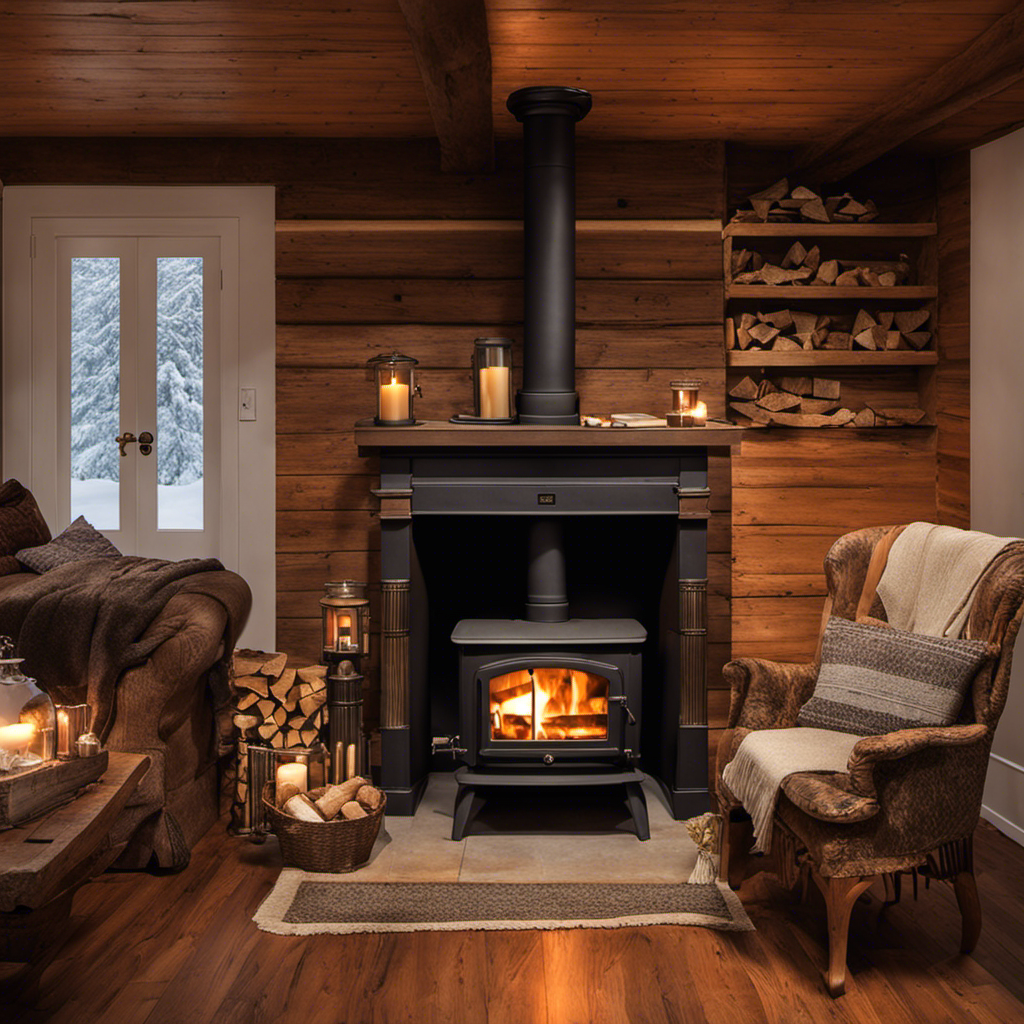
Welcome to our ultimate guide on **wood stove maintenance**! Our goal is to offer you practical advice on how to maximize the efficiency and lifespan of your wood stove. Join us as we explore the ins and outs of proper wood stove care, so you can enjoy cozy fires all winter long. Dive into the world of wood stove maintenance and ensure your appliance is in top shape for years to come. Start your journey to a well-maintained wood stove today!
From cleaning and inspecting to troubleshooting common issues, we’ve got you covered.
Get ready to optimize the performance of your wood stove by learning proper techniques for starting a fire, selecting the best wood, and ensuring efficient airflow.
Let’s dive in and keep your wood stove running smoothly for years to come!
Key Takeaways
- Regular cleaning and maintenance of the wood stove, including the stovepipe and chimney, is essential to prevent creosote buildup and reduce the risk of chimney fires.
- When starting a fire, use dry and lightweight kindling arranged in a crisscross pattern, and gradually add larger pieces of wood as the fire grows.
- Choose dry and seasoned firewood, preferably hardwoods like oak and maple, for efficient combustion and longer burn times.
- Proper air flow control, achieved by adjusting the damper and ensuring sufficient fresh air intake, is crucial for optimal wood stove performance and reducing smoke emissions.
Cleaning and Inspecting Your Wood Stove
We should regularly clean and inspect our wood stove to ensure it’s safe and efficient. Cleaning frequency is essential to prevent the buildup of creosote, a highly flammable substance that can cause chimney fires. It’s recommended to clean the stovepipe and chimney at least once a year, or more frequently if you use your wood stove extensively.
Safety measures should be taken during the cleaning process, such as wearing protective gloves and goggles to avoid any injuries. Before cleaning, make sure the stove is completely cool to prevent burns.
Inspecting the stove regularly is equally important. Check for any cracks or damage in the stove body, door gaskets, and chimney flue. This will help identify and address any potential issues before they become major problems.
Regular cleaning and inspection will ensure the safe and efficient operation of your wood stove.
Proper Techniques for Starting a Fire
When starting a fire, it’s crucial to follow proper techniques to ensure a successful and efficient burn.
Firstly, choosing the right kindling is essential. Dry and lightweight materials such as newspaper or small twigs work best.
Secondly, controlling air flow is important for maintaining a steady and controlled burn. Adjusting the damper or vents on the stove can help regulate the amount of oxygen entering the firebox.
Lastly, proper fuel placement is key. Start with a small stack of kindling arranged in a crisscross pattern, and gradually add larger pieces of wood as the fire grows.
Choosing the Right Kindling
Let’s use small dry twigs as kindling to ensure a quick and successful fire start. Kindling is an essential component in starting a fire as it provides the initial flame and heat necessary to ignite larger pieces of wood. When selecting kindling, it is important to choose dry and lightweight materials that catch fire easily. Here are some popular kindling options:
| Material | Pros |
|---|---|
| Small twigs | Easily accessible |
| Newspaper | Readily available |
| Pine cones | Natural firestarters |
| Dry leaves | Abundant in nature |
| Cardboard | Easy to ignite |
Controlling Air Flow
To effectively control air flow in our wood stove, we should carefully adjust the damper and open the windows slightly to ensure optimal combustion. Proper air flow control is crucial for maintaining a consistent and efficient burn.
By adjusting the damper, we can regulate the amount of oxygen entering the stove, which directly affects the temperature and burn rate. Opening the windows slightly allows for the entry of fresh air, preventing the stove from creating a vacuum effect and promoting better combustion.
It’s important to strike a balance between too much and too little air flow to ensure a clean and efficient burn. By controlling air flow, we can also regulate the temperature inside the stove, preventing it from getting too hot or too cold.
Proper air flow control is a key aspect of maintaining a well-functioning wood stove.
Now, let’s move on to the next important topic: proper fuel placement.
Proper Fuel Placement
By strategically stacking the firewood and kindling, we ensure proper fuel placement, allowing for efficient ignition and a long-lasting fire. Here are four essential steps for proper fuel placement and maximizing fuel efficiency:
-
Use dry and seasoned firewood: Moisture content in firewood greatly affects its combustion efficiency. Proper firewood storage is crucial to ensure dryness and prevent mold growth.
-
Arrange the firewood in a crisscross pattern: Stacking the logs in an alternating pattern allows for better airflow, promoting more efficient burning and reducing smoke production.
-
Start with smaller kindling: Placing kindling at the bottom of the stack ensures an easy ignition, creating a solid base for the fire to grow.
-
Gradually add larger logs: As the fire grows stronger, add larger logs to sustain the heat and maintain a steady burn.
With proper fuel placement, we can achieve optimal fuel efficiency and enjoy a cozy and warm environment.
Now, let’s move on to essential maintenance tasks for your wood stove.
Essential Maintenance Tasks for Your Wood Stove
We should regularly perform the necessary maintenance tasks on our wood stove to ensure its optimal performance and longevity. Wood stove maintenance is crucial for both safety and efficiency.
To start, always begin by following safety precautions. Before performing any maintenance, make sure the stove is cool and the fire has completely extinguished.
Clean the stove regularly to remove any creosote buildup, as this can cause chimney fires. Use a soft brush to clean the stove’s interior and remove any debris.
Additionally, inspect the gaskets regularly and replace them if they’re worn or damaged. Clean the stove’s glass door using a non-abrasive cleaner to maintain visibility.
Finally, check the chimney and flue regularly for any blockages or obstructions.
Selecting the Best Wood for Optimal Performance
When selecting the best wood for optimal performance in a wood stove, there are three key factors to consider.
First, the wood’s moisture content is crucial as it directly affects its burn efficiency and heat output. Dry wood with a moisture content below 20% is ideal for a clean and efficient burn.
Second, the heat output efficiency of the wood is determined by its density and species, with hardwoods like oak and maple generally providing more heat per unit of volume than softwoods.
Lastly, the type of wood chosen can also impact the overall performance, with seasoned hardwoods often being the preferred choice due to their higher energy content and longer burn times.
Wood Moisture Content
As wood stove owners, we always ensure that we regularly check the moisture content of our firewood to guarantee optimal performance. Maintaining the right moisture level is crucial for efficient and clean burning.
Here are some key points to consider when it comes to wood moisture content:
-
Importance of Proper Drying: Properly drying firewood is essential to achieve the desired moisture content. This ensures that the wood burns efficiently and produces less smoke and creosote buildup in the stove and chimney.
-
Ideal Moisture Content: The ideal moisture content for firewood is around 20%. Wood with higher moisture levels will burn less efficiently, leading to increased smoke, lower heat output, and potential damage to the stove and chimney.
-
Proper Wood Storage: Storing firewood properly is crucial for maintaining the desired moisture content. Wood should be stacked in a way that allows for adequate air circulation to facilitate drying.
-
Effective Drying Methods: There are several effective methods for drying firewood, including air drying, using a firewood kiln, or using a moisture meter to monitor the moisture levels.
Heat Output Efficiency
To achieve optimal heat output efficiency, we should select wood that has a low moisture content and burns efficiently.
When it comes to wood stoves, heat distribution plays a crucial role in ensuring maximum comfort and energy savings. Proper heat distribution eliminates hot and cold spots in the room, providing consistent warmth throughout the space. One way to improve heat distribution is by using a heat-powered fan that circulates warm air more effectively.
Additionally, reducing heat loss is essential for maximizing heat output efficiency. Insulating the chimney and sealing any gaps or cracks in the stovepipe can significantly minimize heat loss. Using a heat-resistant glass door can also help retain more heat inside the stove.
Type of Wood
We should consider both the quantity and quality of wood, as using well-seasoned hardwoods will ensure optimal performance in our wood stove. When it comes to wood selection and preparation, there are a few key factors to keep in mind:
-
Moisture Content: It’s crucial to use properly seasoned wood with a moisture content of around 20%. Wet or green wood not only produces less heat but also increases the risk of creosote buildup and inefficient burning.
-
Hardwood vs. Softwood: Hardwoods like oak, maple, and birch are denser and provide a longer burn time with more consistent heat output. Softwoods like pine and fir burn faster but are ideal for starting fires due to their high resin content.
-
Wood Size: Opt for wood pieces that are cut to the right length for your stove, typically around 14 to 18 inches. Smaller pieces may burn too quickly, while larger ones can cause airflow issues.
-
Proper Storage: Store your wood in a dry and well-ventilated area, preferably off the ground, to prevent moisture absorption and ensure it stays properly seasoned.
Considering these factors will help us maximize the efficiency and longevity of our wood stove.
Now, let’s move on to optimizing airflow for efficient burning.
Optimizing Airflow for Efficient Burning
Let’s adjust the damper settings to ensure maximum airflow, resulting in more efficient burning. When it comes to wood stove maintenance, optimizing airflow is crucial for maximizing efficiency and reducing smoke emissions.
The damper controls the amount of air that enters the firebox, influencing the combustion process. To achieve the best airflow, start by fully opening the damper when lighting the fire. This allows for a quick ignition and helps establish a strong draft.
Once the fire is burning steadily, gradually adjust the damper to a partially open position. This will maintain a controlled airflow, ensuring efficient combustion without excessive smoke production.
It’s important to regularly check and clean the damper to prevent any blockages or obstructions that may hinder the airflow. By fine-tuning the damper settings, we can enhance the performance of our wood stoves, ensuring optimal efficiency and minimal smoke output.
Troubleshooting and Resolving Common Issues With Wood Stoves
One common issue with wood stoves is that they often produce excessive smoke and can be resolved by adjusting the damper settings.
Here are some troubleshooting tips for common issues with wood stoves:
-
Check the damper: Ensure that the damper is fully open to allow for proper airflow and efficient burning. If the damper is closed or partially closed, it can result in smoke buildup.
-
Clean the chimney: A buildup of creosote and debris in the chimney can restrict airflow and cause smoke to back up into the house. Regular chimney cleaning is essential to prevent this issue.
-
Use dry firewood: Wet or unseasoned firewood can produce more smoke and lower the efficiency of the wood stove. Make sure to use dry firewood that has been properly seasoned for optimal burning.
-
Adjust the air intake: If the stove is still producing excessive smoke even with the damper fully open, try adjusting the air intake. Increasing the air supply can help improve combustion and reduce smoke output.
Frequently Asked Questions
How Often Should I Clean My Wood Stove?
We clean our wood stove regularly to ensure optimal performance. Regular cleaning helps prevent creosote buildup and reduces the risk of chimney fires. Following best practices for wood stove maintenance includes cleaning at least once a year.
What Are Some Signs That My Wood Stove Needs Repair?
Common wood stove repair signs include excessive smoke, difficulty starting a fire, and strange odors. If you notice these issues, it’s best to call a professional to assess and repair your wood stove.
Can I Use Any Type of Wood in My Wood Stove?
Yes, we can use different types of wood in our wood stove. However, it is important to consider the burning efficiency and heat output of each wood type to ensure optimal performance.
How Can I Prevent Creosote Buildup in My Chimney?
To prevent chimney fires and remove creosote buildup, we recommend regular chimney inspections, proper wood burning techniques, and annual chimney cleanings. This ensures the safe and efficient operation of your wood stove.
Are There Any Safety Precautions I Should Take When Using a Wood Stove?
When using a wood stove, it’s vital to prioritize safety. Make sure to take necessary precautions, such as proper ventilation and regular maintenance. By doing so, we can ensure a secure and efficient wood stove experience for everyone.
Conclusion
In conclusion, maintaining and caring for your wood stove is crucial for its effective use and longevity. By regularly cleaning and inspecting your stove, using proper techniques for starting a fire, performing essential maintenance tasks, selecting the best wood, and optimizing airflow, you can ensure optimal performance and efficient burning.
Remember, a well-maintained wood stove not only provides warmth but also creates a cozy atmosphere. The crackling flames dance and the scent of burning wood fills the air, inviting you to relax and unwind.
Growing up surrounded by the vast beauty of nature, Sierra was always drawn to the call of the wild. While others sought the comfort of the familiar, she ventured out, embracing the unpredictable and finding stories in the heartbeat of nature.
At the epicenter of every remarkable venture lies a dynamic team—a fusion of diverse talents, visions, and passions. The essence of Best Small Wood Stoves is crafted and refined by such a trio: Sierra, Logan, and Terra. Their collective expertise has transformed the platform into a leading authority on small wood stoves, radiating warmth and knowledge in equal measure.
Installation & Maintenance
How To Installation A Lowes Wood Stove Chimney
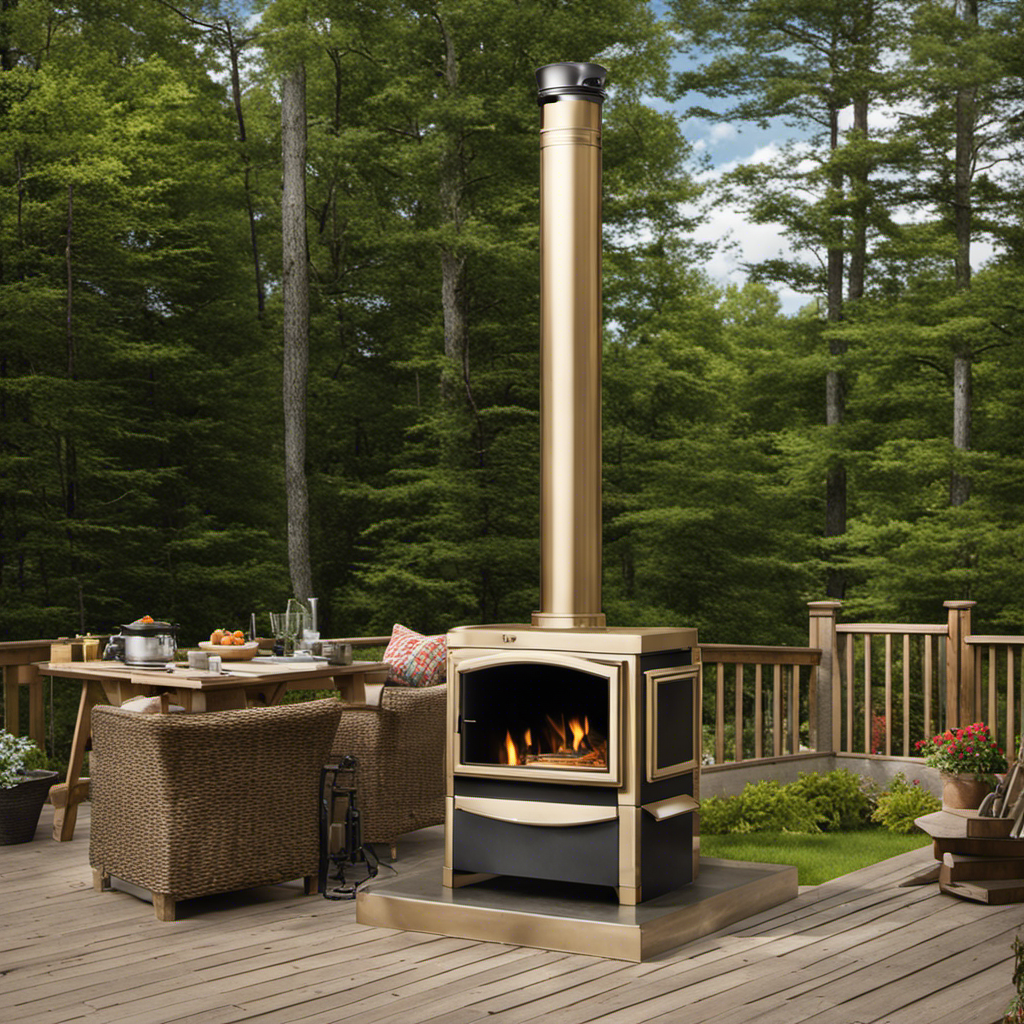
During my quest to grasp the complexities of wood stove installation, I’ve learned that success hinges on ensuring the chimney is correctly set up.
In this guide, I’ll walk you through the step-by-step process of installing a Lowes wood stove chimney.
From understanding the components to choosing the right location, I’ll provide all the detailed instructions you need.
So, let’s roll up our sleeves and get ready to bring warmth and coziness to your home.
Key Takeaways
- Components work together for proper ventilation
- Regular cleaning and inspection are essential
- Choose the right location and materials for safety and efficiency
- Thoroughly prepare your home and follow local building codes and regulations
Understanding the Components of a Lowes Wood Stove Chimney
I understand the components of a Lowes wood stove chimney and how they work together to ensure proper ventilation. One common problem with chimneys is the buildup of creosote, a flammable substance that can cause chimney fires. To prevent this, regular cleaning and inspection are essential.
Another issue is blockage caused by debris, such as leaves or animal nests. This can restrict airflow and lead to poor ventilation. It’s important to install a chimney cap to prevent these blockages.
Additionally, safety precautions should be taken when using a wood stove chimney. This includes using a spark arrester to prevent sparks from igniting nearby combustible materials.
Regular maintenance and following safety guidelines will help ensure the efficient and safe operation of your Lowes wood stove chimney.
Choosing the Right Location for Your Wood Stove Chimney
There are two main factors to consider when choosing the right location for your wood stove chimney: safety and efficiency. It is important to select a location that minimizes the risk of fire and carbon monoxide buildup, while also maximizing the stove’s heating capabilities. Here are some essential safety precautions for wood stove chimney installation:
- Keep the chimney at least 2 feet above the highest point where it passes through the roof.
- Install a chimney cap to prevent birds, animals, and debris from entering.
- Use only approved materials for the chimney, such as stainless steel or insulated double-wall pipe.
- Ensure proper clearance from combustible materials, following manufacturer guidelines.
- Regularly inspect and clean the chimney to prevent creosote buildup.
By following these precautions and choosing the best materials for your wood stove chimney, you can enjoy a safe and efficient heating system for your home.
| Safety Precautions | Materials |
|---|---|
| Keep chimney above roof | Stainless steel or insulated double-wall pipe |
| Install chimney cap | Follow manufacturer guidelines for clearance |
| Regularly inspect and clean chimney |
Preparing Your Home for Wood Stove Chimney Installation
To ensure a smooth and successful wood stove chimney installation, it’s essential to thoroughly prepare your home and gather all the necessary materials.
When it comes to choosing the right materials for your wood stove chimney, there are a few key factors to consider. First and foremost, you’ll want to make sure that the materials are rated for high temperatures to prevent any potential fire hazards. Additionally, it’s important to choose materials that are durable and long-lasting, as a chimney is a substantial investment.
Common mistakes to avoid during wood stove chimney installation include failing to properly measure and plan for the chimney’s height and clearance requirements. It’s also crucial to follow all local building codes and regulations to ensure that your installation is safe and compliant.
Step-by-Step Guide to Installing a Lowes Wood Stove Chimney
I carefully followed the step-by-step guide and successfully installed a Lowes wood stove chimney with ease and confidence. It was a rewarding experience, knowing that I was taking the necessary steps to ensure the safety and functionality of my wood stove.
However, installing the chimney is just the beginning. Proper maintenance is crucial for the chimney to work efficiently and prevent any potential problems. Here are some important maintenance tips to keep in mind:
- Regularly inspect and clean the chimney to remove any creosote buildup.
- Check for any cracks or damage that may occur over time and repair them promptly.
- Ensure that the chimney cap is in good condition to prevent water and debris from entering.
- Keep an eye out for signs of chimney fires, such as excessive smoke or a strong, pungent odor.
Is a Permit Required for Installing a Lowes Wood Stove Chimney?
Yes, a permit for wood stove installation is required when installing a Lowes wood stove chimney. This is to ensure safety and compliance with local building codes. It’s important to check with your local building department to understand the specific requirements for obtaining a permit for wood stove installation in your area.
Tips for Maintaining and Troubleshooting Your Wood Stove Chimney
Regularly inspecting and cleaning the chimney, as well as promptly repairing any cracks or damage, are essential for maintaining and troubleshooting your wood stove chimney.
One of the most common chimney problems is the buildup of creosote, a flammable substance that can lead to chimney fires. To prevent this, it’s recommended to have your chimney professionally cleaned at least once a year.
Additionally, make sure to check for any obstructions such as bird nests or debris that could block the airflow.
Another common issue is the development of cracks or leaks in the chimney, which can cause smoke to seep into your home. If you notice any cracks, it’s crucial to repair them immediately using a high-temperature sealant.
Frequently Asked Questions
Can I Install a Lowes Wood Stove Chimney Myself, or Do I Need to Hire a Professional?
I can install a Lowes wood stove chimney myself, but it’s important to consider the pros and cons. DIY installation saves money, but hiring a professional ensures proper installation and compliance with local regulations.
How Often Should I Clean My Lowes Wood Stove Chimney?
I clean my Lowes wood stove chimney as often as I clean my teeth, which is to say, regularly. Signs that it needs cleaning include excessive smoke, a strong odor, or a decrease in stove efficiency.
What Type of Wood Should I Use in My Wood Stove to Maximize Efficiency?
To maximize efficiency in my wood stove, I use hardwoods like oak or maple. They burn longer and release more heat. It’s important to properly season the wood and ensure it’s dry for optimal performance.
Are There Any Specific Building Codes or Regulations I Need to Adhere to When Installing a Wood Stove Chimney?
Building code requirements and safety regulations must be followed when installing a wood stove chimney. It is important to ensure the chimney is properly installed and meets all necessary standards to ensure safety and compliance.
What Should I Do if I Notice a Leak or Smoke Coming From My Wood Stove Chimney?
If I notice a leak or smoke coming from my wood stove chimney, I would first inspect the chimney for any visible damage or cracks. Then, I would proceed with repairing chimney leaks and troubleshooting chimney smoke as needed.
Conclusion
To wrap things up, installing a Lowes wood stove chimney can be a rewarding project for any homeowner. By understanding the components, choosing the right location, and following a step-by-step guide, you can enjoy the warmth and comfort of a wood stove in your home.
Remember to regularly maintain and troubleshoot your chimney to ensure its efficiency and safety. So go ahead, embrace the cozy atmosphere and start enjoying the benefits of a wood stove chimney!
Logan’s affair with adventure began in childhood. He hailed from a small town where vast forests bordered one side and endless shores stretched on the other. His days were spent exploring uncharted woods, climbing tall trees, or listening to the tales of old sailors. This early immersion in a world brimming with stories and mysteries became the foundation of his passion for writing.
Installation & Maintenance
How Often Should I Clean My Wood Stove?

Key Takeaways
- The type of wood burned affects creosote buildup, with hardwoods producing less creosote than softwoods.
- The frequency of use impacts cleaning needs, with more frequent use or softer woods potentially requiring more cleaning.
- Regular cleaning maintains efficiency and prevents hazards, and it is recommended to clean a wood stove at least once a year.
- Cleaning the firebox, chimney, and flue thoroughly is essential for maintaining a clean and efficient wood stove.
Factors to Consider When Determining Cleaning Frequency
Signs That Indicate It’s Time to Clean Your Wood Stove
If you’re noticing a buildup of ash or a decrease in heat output, it’s time to give your wood stove a good cleaning. Cleaning your wood stove is essential for maintaining its efficiency and preventing potential fire hazards. When to clean your wood stove depends on how often you use it and the type of wood you burn. As a general rule of thumb, it’s recommended to clean your wood stove at least once a year, preferably before the heating season begins. However, if you use your stove frequently or burn softer woods like pine, you may need to clean it more often. Cleaning your wood stove efficiently involves removing ash and soot from the firebox, chimney, and flue. By keeping your wood stove clean, you can ensure optimal performance and extend its lifespan. As we transition into the subsequent section about how to clean your wood stove, it’s important to understand the step-by-step guide for a thorough cleaning process.Step-By-Step Guide on How to Clean Your Wood Stove
| Supplies Needed | Steps to Follow |
|---|---|
| Ash bucket | 1. Let the stove cool down completely. |
| Metal scoop | 2. Open the stove door and remove the ashes using a metal scoop. |
| Stiff brush | 3. Clean the interior surfaces, including the firebox, grates, and baffle plates, with a stiff brush. |
Maintenance Tips to Keep Your Wood Stove Clean and Efficient
To keep your wood stove running smoothly, it’s important to regularly inspect the chimney and flue for any blockages or buildup. Here are some maintenance tips to help keep your wood stove clean and efficient:- Create a maintenance schedule: Set a regular schedule to inspect and clean your wood stove to prevent any potential issues. This will ensure that your stove operates at its best and reduces the risk of chimney fires.
- Use the right cleaning products: Invest in high-quality cleaning products specifically designed for wood stoves. These products are formulated to effectively remove creosote and soot buildup without damaging the stove or chimney.
- Clean the ash regularly: Remove the ash buildup from the stove at least once a week. Excessive ash can reduce the stove’s efficiency and increase the risk of fire.
- Inspect the gaskets: Check the gaskets around the stove door and replace them if they are worn or damaged. This will help maintain a proper seal and prevent air leaks.
Professional Cleaning Vs. DIY Cleaning: Which Option Is Best for You?
When deciding between professional cleaning and DIY cleaning for your wood stove, you’ll need to consider your budget, time availability, and level of expertise. Both options have their pros and cons, so it’s important to weigh them carefully before making a decision. Professional cleaning offers a thorough and efficient service, ensuring that your wood stove is cleaned to a high standard. They have the expertise and specialized tools to remove stubborn soot and creosote buildup, reducing the risk of chimney fires. However, professional cleaning can be expensive, especially if you require regular maintenance. On the other hand, DIY cleaning is a cost-effective option that allows you to clean your wood stove at your own convenience. It requires some time and effort, but with the right tools and knowledge, you can effectively remove ash, debris, and light soot. However, DIY cleaning may not be as thorough as professional cleaning, and if done incorrectly, it can even cause damage to your wood stove. Ultimately, the choice between professional cleaning and DIY cleaning depends on your individual circumstances. Consider your budget, time availability, and level of expertise to determine which option is best for you.Frequently Asked Questions
Can I Use Regular Household Cleaning Products to Clean My Wood Stove?
I clean my wood stove regularly to maintain its efficiency. Household cleaning products may not be the best option. Instead, consider using alternatives like vinegar or specialized stove cleaners for effective and safe cleaning.Is It Necessary to Clean the Glass Window on My Wood Stove?
Cleaning the glass window on a wood stove is essential for maintaining its efficiency and appearance. Regular cleaning prevents the buildup of soot and allows for a clear view of the flames. However, homemade cleaners may not be as effective as specialized products.How Often Should I Clean the Chimney Connected to My Wood Stove?
Cleaning the chimney connected to my wood stove is essential for proper maintenance. Regular chimney cleaning techniques should be employed to prevent buildup and ensure optimal performance.What Are the Potential Dangers of Not Cleaning My Wood Stove Regularly?
Neglecting wood stove cleaning can lead to potential dangers. Regular maintenance is important to prevent chimney fires, carbon monoxide poisoning, and reduced efficiency. Protect your home and family by cleaning your wood stove regularly.Are There Any Specific Tools or Equipment I Need to Clean My Wood Stove?
When it comes to cleaning my wood stove, having the right tools is key. A brush, ash shovel, and vacuum are essential for removing debris. The cleaning process can be time-consuming, but it’s necessary for optimal performance and safety.How Often Should I Clean My Wood Stove When Installed in an Apartment?
Ensuring your wood stove operates at its best after installing it in an apartment requires routine cleaning. For optimal efficiency and to prevent creosote accumulation, it’s recommended that you clean the stove at least monthly. Consistent upkeep not only prolongs your stove’s lifespan but also minimizes fire risks. Always adhere to the recommendations provided by the manufacturer for correct cleaning methods and safety measures, particularly when handling a wood stove installation in an apartment.
Conclusion
In conclusion, regular cleaning of your wood stove is essential to maintain its efficiency and prevent potential hazards. According to a survey conducted by the National Fire Protection Association, it is recommended to clean your wood stove at least once every year. This statistic paints a vivid picture of the importance of keeping your wood stove clean to ensure it functions properly and reduces the risk of fires. By following the step-by-step guide and implementing the maintenance tips mentioned in this article, you can enjoy a clean and efficient wood stove all year round.Logan’s affair with adventure began in childhood. He hailed from a small town where vast forests bordered one side and endless shores stretched on the other. His days were spent exploring uncharted woods, climbing tall trees, or listening to the tales of old sailors. This early immersion in a world brimming with stories and mysteries became the foundation of his passion for writing.
-

 Wood Stove3 months ago
Wood Stove3 months agoHow To Build A Thermoelectric Generator For A Wood Stove
-
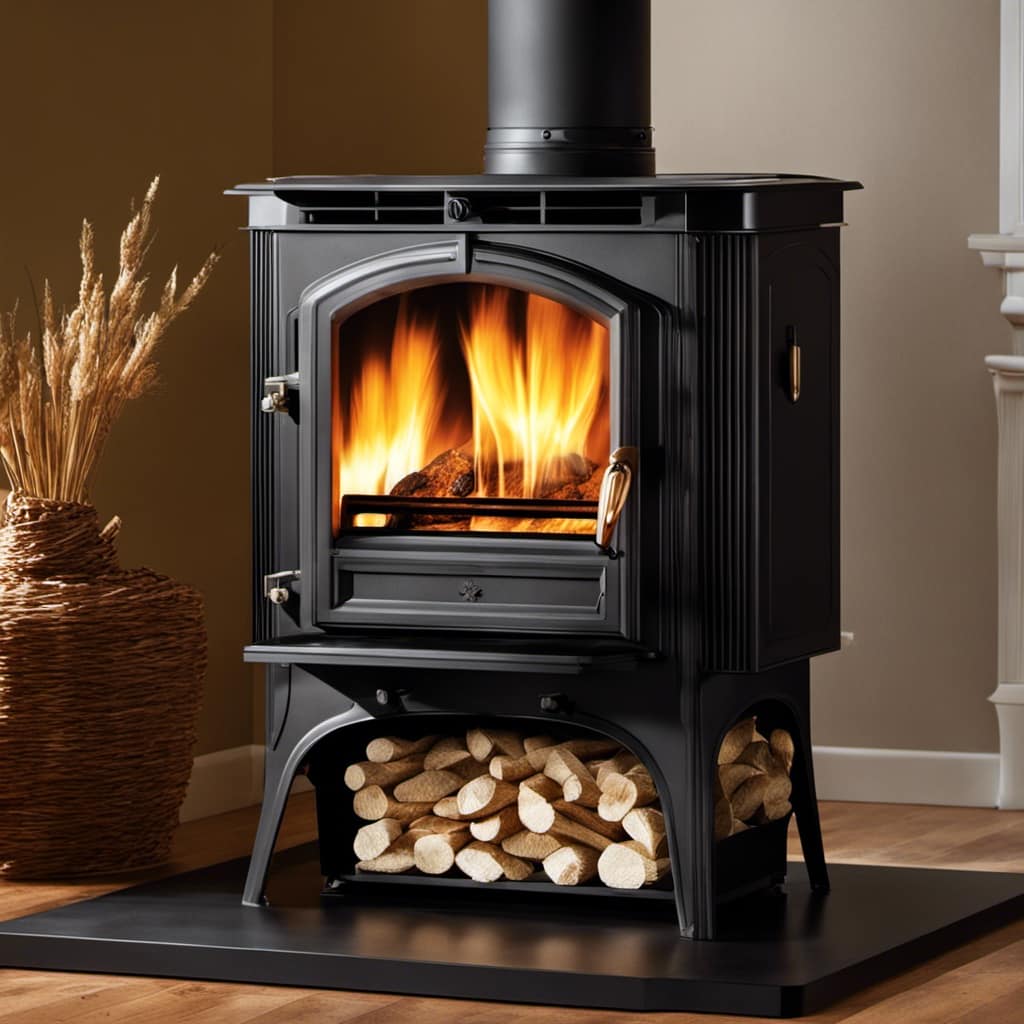
 Wood Stove4 months ago
Wood Stove4 months agoHow To Use Damper And Draft On Wood Stove
-

 Wood Stove4 months ago
Wood Stove4 months agoWhen To Open And Close Damper On Wood Stove
-

 Wood Stove4 months ago
Wood Stove4 months agoHow Far Does Wood Stove Have To Be From Wall
-

 Wood Stove3 months ago
Wood Stove3 months agoHow Does A Circulator Wood Stove Work
-
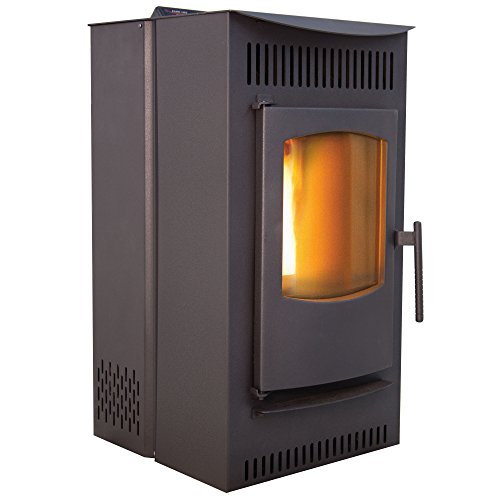
 Pellet Stoves3 months ago
Pellet Stoves3 months agoWhy Is My Wood Pellet Stove Putting so Much Soot
-
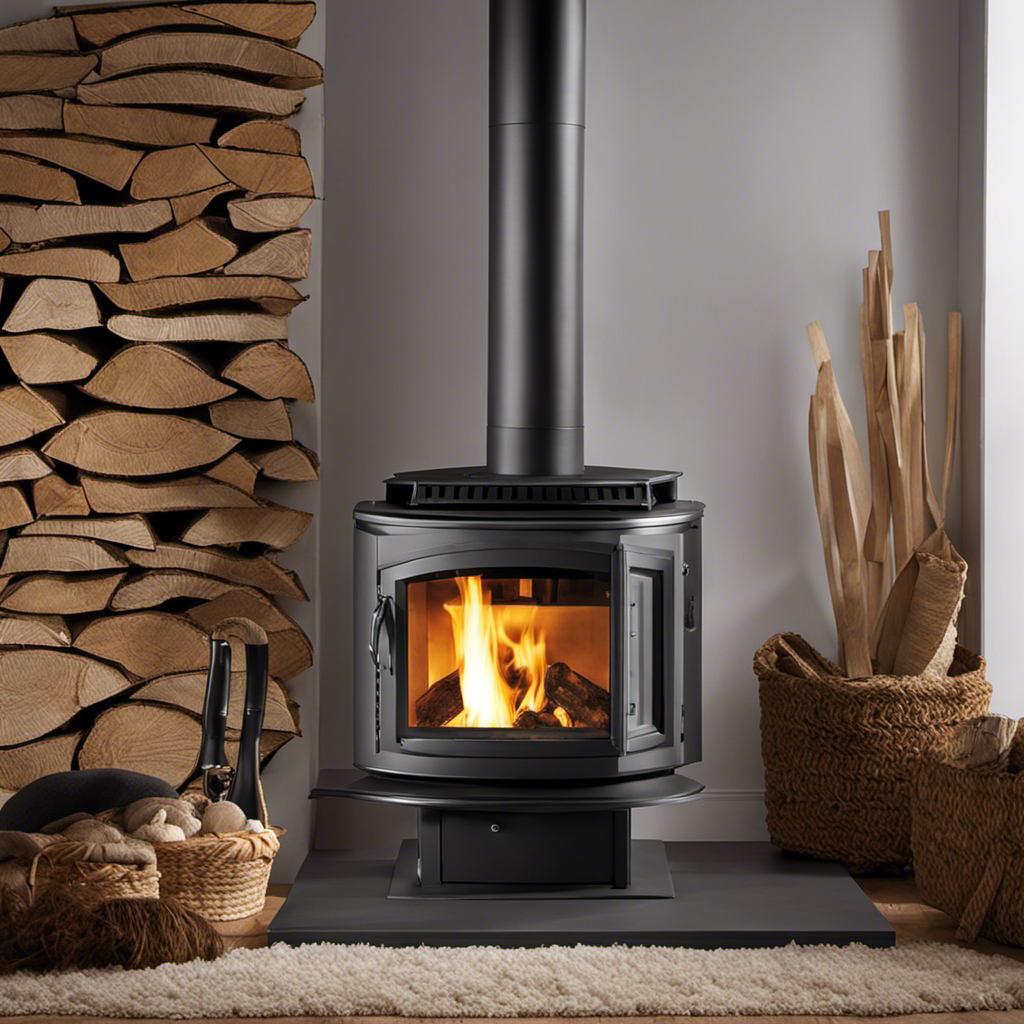
 Wood Stove4 months ago
Wood Stove4 months agoWhat Can I Use As Insulation On Wood Stove Pipes
-
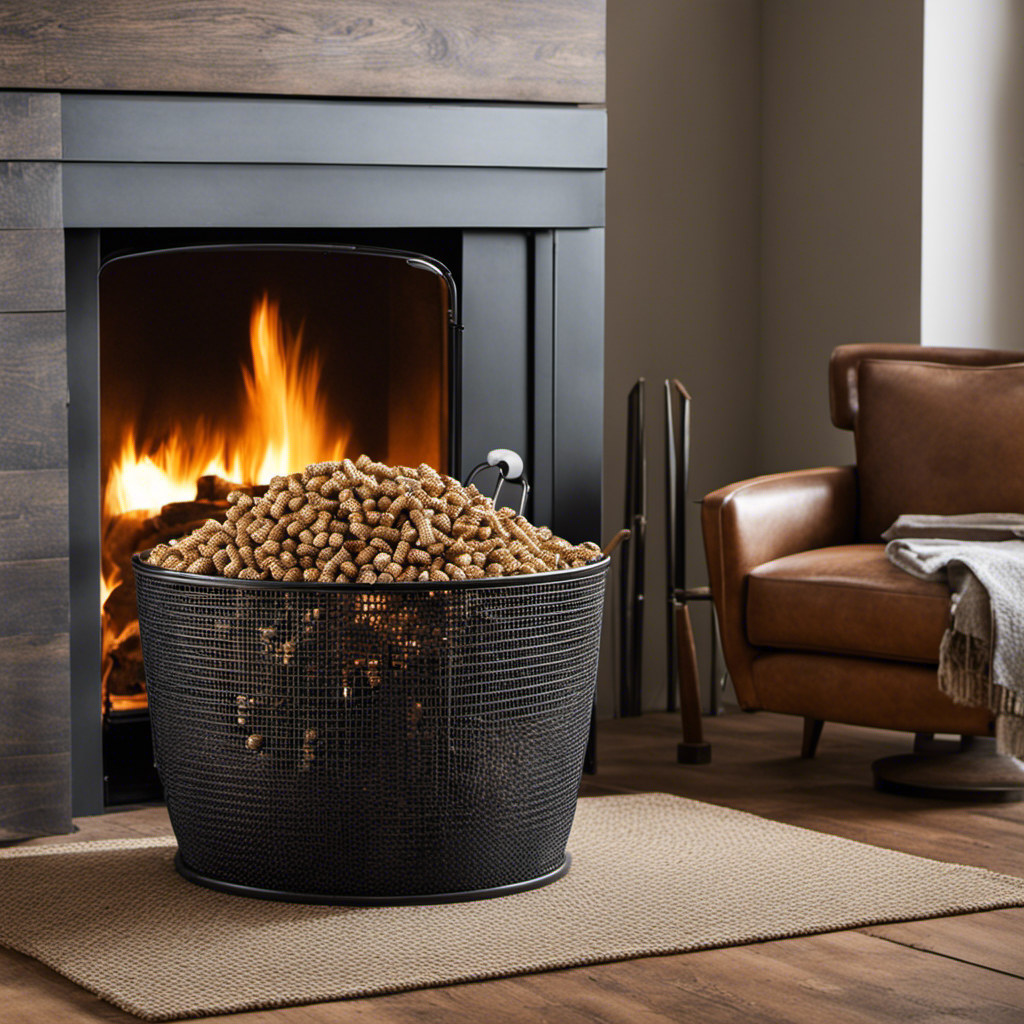
 Pellet Stoves3 months ago
Pellet Stoves3 months agoHow to Make a Pellet Basket for Wood Burning Stoves









